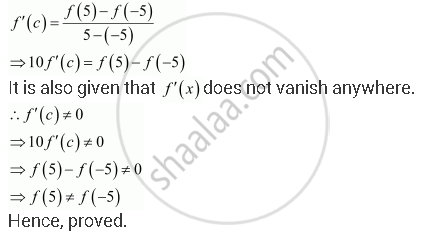Advertisements
Advertisements
प्रश्न
If f : [– 5, 5] → R is a differentiable function and if f ′(x) does not vanish anywhere, then prove that f (– 5) ≠ f (5).
उत्तर
It is given that f : [– 5, 5] → R is a differentiable function.
Since every differentiable function is a continuous function, we obtain
(a) f is continuous on [−5, 5].
(b) f is differentiable on (−5, 5).
Therefore, by the Mean Value Theorem, there exists c ∈ (−5, 5) such that

APPEARS IN
संबंधित प्रश्न
Verify Lagrange’s mean value theorem for the function f(x)=x+1/x, x ∈ [1, 3]
Check whether the conditions of Rolle’s theorem are satisfied by the function
f (x) = (x - 1) (x - 2) (x - 3), x ∈ [1, 3]
Examine if Rolle’s Theorem is applicable to any of the following functions. Can you say some thing about the converse of Rolle’s Theorem from these examples?
f (x) = [x] for x ∈ [5, 9]
Examine if Rolle’s Theorem is applicable to any of the following functions. Can you say some thing about the converse of Rolle’s Theorem from these examples?
f (x) = x2 – 1 for x ∈ [1, 2]
Verify Rolle’s theorem for the following function:
`f(x) = e^(-x) sinx " on" [0, pi]`
f(x) = (x-1)(x-2)(x-3) , x ε[0,4], find if 'c' LMVT can be applied
Verify the Lagrange’s mean value theorem for the function:
`f(x)=x + 1/x ` in the interval [1, 3]
Verify Langrange’s mean value theorem for the function:
f(x) = x (1 – log x) and find the value of c in the interval [1, 2].
Verify Rolle’s Theorem for the function f(x) = ex (sin x – cos x) on `[ (π)/(4), (5π)/(4)]`.
Verify Mean value theorem for the function f(x) = 2sin x + sin 2x on [0, π].
Verify Rolle’s theorem for the function, f(x) = sin 2x in `[0, pi/2]`.
Verify mean value theorem for the function f(x) = (x – 3)(x – 6)(x – 9) in [3, 5].
The value of c in Mean value theorem for the function f(x) = x(x – 2), x ∈ [1, 2] is ______.
f(x) = x(x – 1)2 in [0, 1]
f(x) = `sin^4x + cos^4x` in `[0, pi/2]`
f(x) = log(x2 + 2) – log3 in [–1, 1]
Discuss the applicability of Rolle’s theorem on the function given by f(x) = `{{:(x^2 + 1",", "if" 0 ≤ x ≤ 1),(3 - x",", "if" 1 ≤ x ≤ 2):}`
Using Rolle’s theorem, find the point on the curve y = x(x – 4), x ∈ [0, 4], where the tangent is parallel to x-axis
f(x) = sinx – sin2x in [0, π]
f(x) = `sqrt(25 - x^2)` in [1, 5]
Using mean value theorem, prove that there is a point on the curve y = 2x2 – 5x + 3 between the points A(1, 0) and B(2, 1), where tangent is parallel to the chord AB. Also, find that point
The value of c in Rolle’s theorem for the function f(x) = x3 – 3x in the interval `[0, sqrt(3)]` is ______.
For the function f(x) = `x + 1/x`, x ∈ [1, 3], the value of c for mean value theorem is ______.
Rolle’s theorem is applicable for the function f(x) = |x – 1| in [0, 2].
If x2 + y2 = 1, then ____________.
The value of c in Rolle’s theorem for the function, f(x) = sin 2x in `[0, pi/2]` is ____________.
The value of c in mean value theorem for the function f(x) = (x - 3)(x - 6)(x - 9) in [3, 5] is ____________.
Value of' 'c' of the mean value theorem for the function `f(x) = x(x - 2)`, when a = 0, b = 3/2, is
If `1/(a + ω) + 1/(b + ω) + 1/(c + ω) + 1/(d + ω) = 1/ω`, where a, b, c, d ∈ R and ω is a cube root of unity then `sum 3/(a^2 - a + 1)` is equal to
Rolle's Theorem holds for the function x3 + bx2 + cx, 1 ≤ x ≤ 2 at the point `4/3`, the value of b and c are
Let a function f: R→R be defined as
f(x) = `{(sinx - e^x",", if x < 0),(a + [-x]",", if 0 < x < 1),(2x - b",", if x > 1):}`
where [x] is the greatest integer less than or equal to x. If f is continuous on R, then (a + b) is equal to ______.
`lim_(x→0) sqrt(1 - cosx)/(sqrt(2)x)` is ______.
Let f(1) = –2 and f'(x) ≥ 4.2 for 1 ≤ x ≤ 6. The possible value of f(6) lies in the interval ______.
